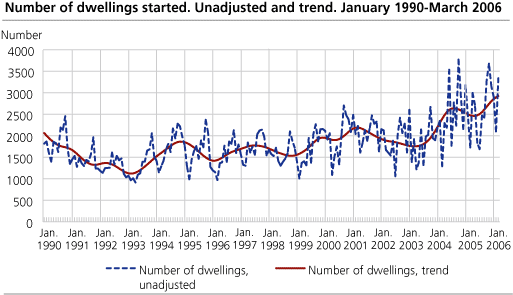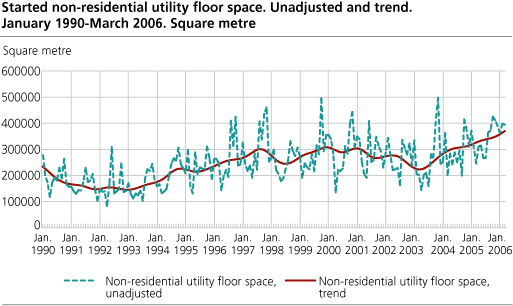Content
Published:
This is an archived release.
More new dwellings
After two months with decrease in dwelling starts compared with last year, it was recorded an increase in March this year. The preliminary monthly figures shows that building of a total of 3 338 dwellings where started in March this year.
In the corresponding month last year 1 727 new dwellings where recorded started.
In the first quarter of 2006, a total of 8 346 dwellings were started - an increase of 13.4 per cent compared with the corresponding quarter last year. The total utility floor space for these new dwellings is 986 400 square meters, an increase of 8.4 per cent compared with the same period in 2005. Some of the explanation to the increase is the fact that the Easter this year was in the first quarter (March), while it last year was in the second one (April).
Also increased building of non-residential buildings
During the first three months this year 1 252 500 square metres of utility floor space were started in non-residential buildings, 21.4 per cent more than during the corresponding period last year.
Of this, 939 500 square metres of floor space is industrial buildings and 313 000 square metres is holiday properties and private garages. For these two building categories there has been an increase of 19.6 and 27 per cent respectively compared with the same period in 2005.
Tables:
- Table 1 Building work started. Preliminary figures
- Table 2 Building activity in March. Preliminary figures
- Table 3 Building work started in January-March, by county. Preliminary figures
- Table 4 Buildings under conctruction per 31 March, by county. Preliminary figures
- Table 5 Buildings completed in January-March, by county. Preliminary figures
- Table 6 Building work started. Not adjusted, seasonally adjusted and trend
- Table 7 Building work started in March, by county. Preliminary figures
- Table 8 Buildings permits in March. Preliminary figures. Breakdown according to Eurostat classifications
- Table 9 Average monthly registration delay for buildings started. January 2003-March 2006
Contact
-
Jens Mathiesen
E-mail: jens.mathiesen@ssb.no
tel.: (+47) 40 81 13 98
-
Magnus Espeland
E-mail: magnus.espeland@ssb.no
tel.: (+47) 45 27 40 08


